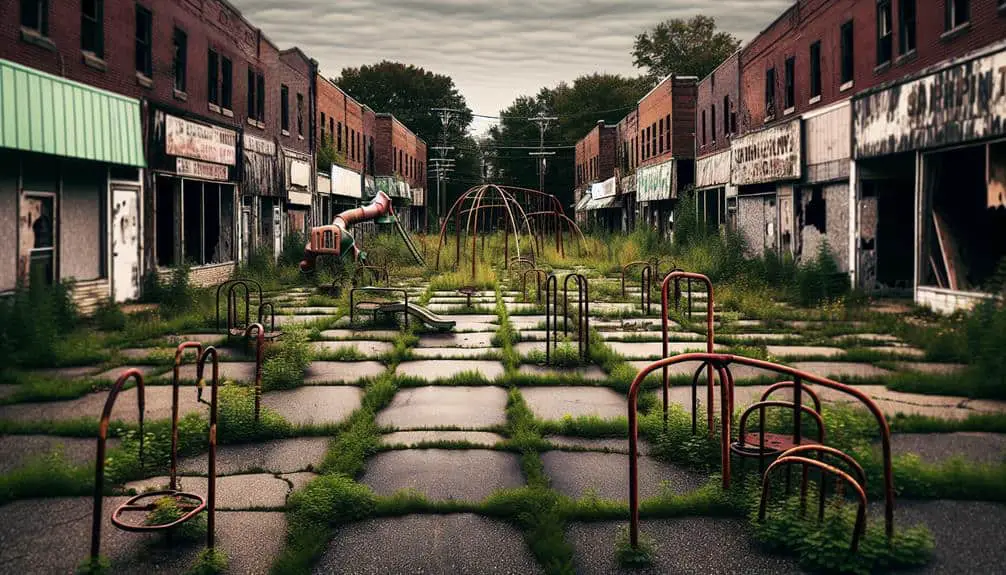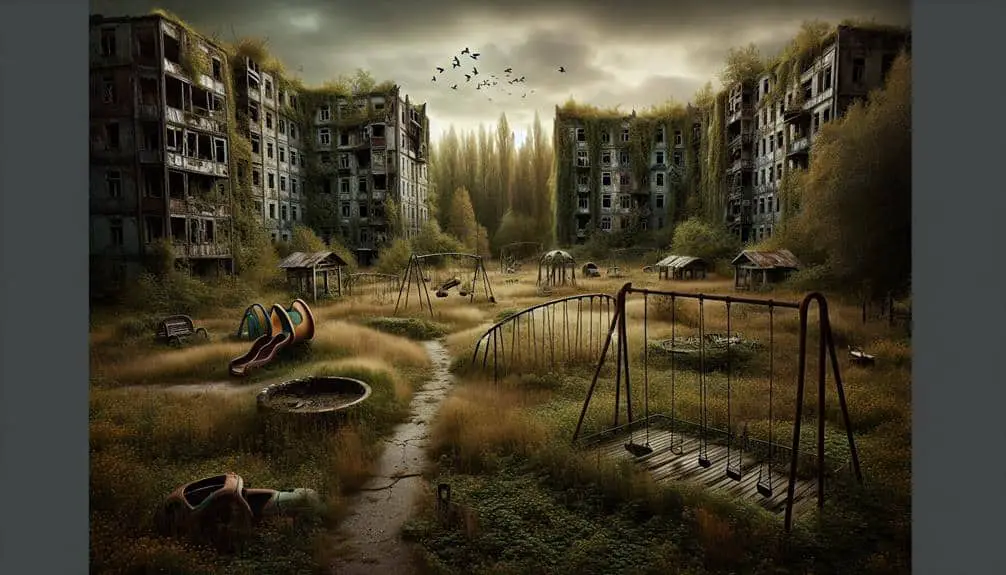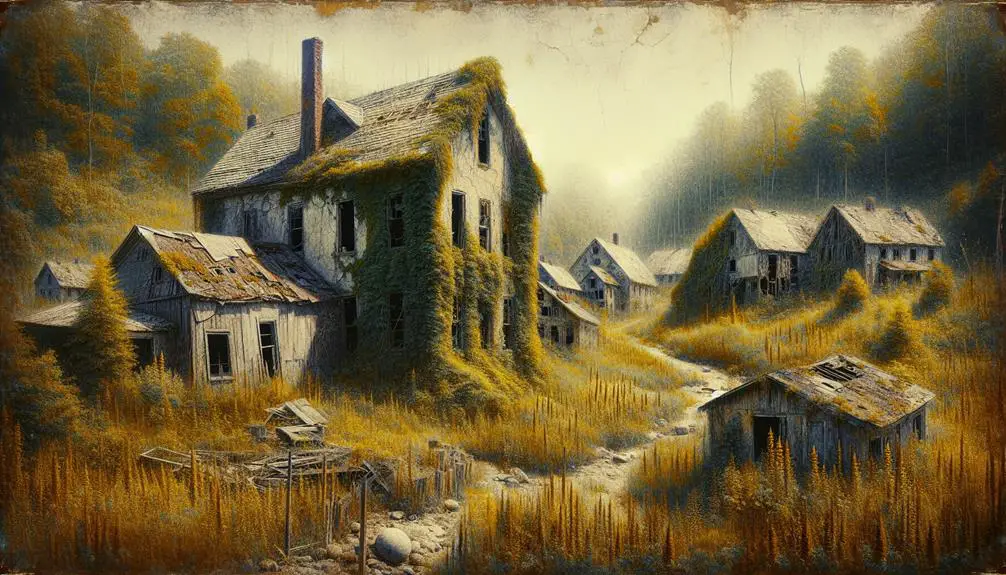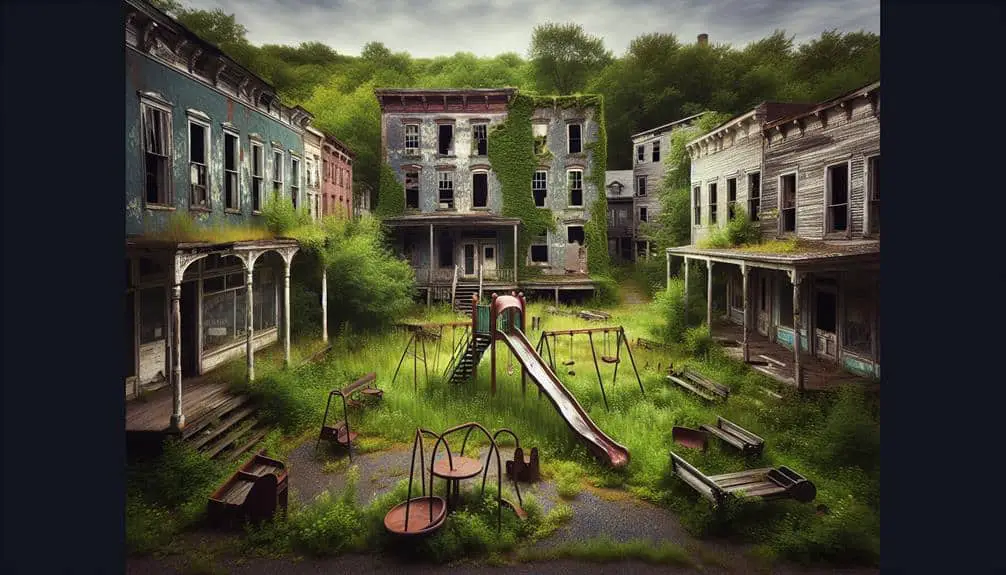Explore the haunting remnants of failed American utopian communities like New Harmony, Brook Farm, Aztalan, Helvetia, and Icaria. Witness the rise and fall of these societies, from Indiana to Massachusetts, Wisconsin, and beyond. Marvel at the ancient mysteries, abandoned structures, and the echoes of unrealized dreams. Discover the complexities of communal living, internal conflicts, and the pursuit of idealism. Each place tells a story of hope, struggle, and resilience, leaving you intrigued by the untold tales of these lost utopias. Immerse yourself in the rich history of failed American communities and reveal the secrets of these forgotten worlds.
Key Points
- New Harmony and Brook Farm faced internal conflicts and financial struggles, leading to their downfall.
- Aztalan, a prehistoric Native American settlement in Wisconsin, holds archaeological mysteries and social complexity.
- Helvetia's abandoned town reflects resilience and loss through its desolate streets and forgotten artifacts.
- Icaria, a commune founded on socialist ideals, succumbed to internal disputes and external pressures.
- These failed American communities leave behind remnants of forgotten dreams, echoing the human quest for utopia.
The Rise and Fall of New Harmony
During the early 19th century, New Harmony experienced a swift rise in prominence followed by a dramatic decline, exemplifying the complexities of communal living experiments. Founded in Indiana by Robert Owen in 1825, New Harmony was envisioned as a utopian community where individuals could escape the societal constraints of the time and live harmoniously in a collective setting. This experiment in alternative lifestyles attracted intellectuals, scientists, and artists keen to explore new ways of living and working together.
Despite its initial promise, New Harmony struggled to sustain itself due to internal conflicts, financial difficulties, and conflicting ideologies among its residents. The communal living experiment faced challenges in balancing individual freedom with collective responsibility, leading to its eventual decline. This rise and fall of New Harmony serve as a poignant reminder of the difficulties inherent in attempting to create utopian societies and the complexities involved in societal experiments aimed at fostering alternative lifestyles.
The Mysterious Ruins of Brook Farm
Exploring the enigmatic remnants of Brook Farm reveals a compelling narrative of idealism confronting reality, shedding light on the complexities of communal living experiments in American history. Founded in the 1840s as a transcendentalist community in Massachusetts, Brook Farm was a mysterious cult that aimed to create a utopian society based on shared labor and intellectual pursuits. However, this failed experiment ultimately succumbed to financial difficulties and internal conflicts, leaving behind haunting ruins that tell a story of hope and disillusionment.
- Moss-covered stone cottages stand as silent witnesses to a bygone era.
- The rusted remains of communal farming equipment evoke visions of industrious labor.
- Crumbling walls adorned with ivy whisper tales of camaraderie and strife.
- The abandoned dairy barn echoes with the ghosts of failed idealism.
These remnants of Brook Farm serve as a poignant reminder of the fragility of utopian dreams and the enduring allure of communal living despite its challenges.
The Forgotten Community of Aztalan
The enigmatic remnants of Brook Farm offer a glimpse into failed American communities, setting the stage for exploring the forgotten community of Aztalan in a similar light. Located in Wisconsin, Aztalan is a site shrouded in ancient mysteries and rich archaeological discoveries. This prehistoric Native American settlement dates back over a thousand years, revealing a society that once thrived in the heart of the Midwest.
Archaeological excavations at Aztalan have unearthed fascinating insights into the lives of its former inhabitants. The earthen mounds, believed to have been ceremonial in nature, stand as affirmations to a complex social structure and religious practices. The layout of the community, with its distinctive palisade walls and central plaza, speaks volumes about the organization and unity of the people who called Aztalan home.
Despite the allure of its archaeological treasures, Aztalan remains a forgotten community in the annals of American history. Its significance lies not only in the physical remnants left behind but also in the stories waiting to be uncovered, shedding light on a chapter of the past that continues to intrigue and captivate modern minds.
Exploring the Abandoned Town of Helvetia
The desolate streets of Helvetia whisper tales of abandonment and faded memories, echoing the bygone hopes and dreams of a once-thriving community. As you explore this ghost town, the remnants of its history come to light:
- Abandoned Buildings: Crumbling structures stand as silent witnesses to the passage of time, their walls adorned with graffiti, telling a story of neglect and decay.
- Overgrown Pathways: Nature has begun to reclaim what was once built by human hands, with ivy creeping up the sides of buildings and trees sprouting through cracked pavement.
- Forgotten Artifacts: Scattered remnants of daily life lay strewn across the ground – rusted tools, broken furniture, and weathered photographs, offering glimpses into the past.
- Eerie Silence: The air is thick with a sense of abandonment, broken only by the occasional creaking of a loose board or the rustling of leaves in the wind.
Exploring the history of Helvetia brings to light a tapestry of cultural significance woven with threads of resilience and loss, painting a vivid picture of a community that once thrived but now lies in desolation.
Uncovering the Secrets of Icaria
As you investigate the enigmatic history of Icaria, a once vibrant community shrouded in mystery and intrigue, layers of untold secrets begin to uncover, revealing a narrative waiting to be revealed. Icaria's legacy is one of both fascination and sorrow, with its utopian ideals and ultimate demise leaving behind a wealth of hidden treasures for those willing to explore its past.
Founded by French socialist Étienne Cabet in the mid-19th century, Icaria was envisioned as a communal society based on equality and fraternity. However, internal conflicts and external pressures led to its eventual downfall, leaving behind deserted buildings and forgotten dreams. Despite its failure, Icaria's legacy endures, offering insights into the complexities of communal living and the pursuit of a better society.
Exploring the ruins of Icaria today, one can still sense the hopes and struggles of its former inhabitants. Uncovering the secrets of this lost utopia allows us to reflect on the human desire for freedom and equality, and the challenges inherent in realizing such ideals on a communal scale.
Frequently Asked Questions
What Caused the Downfall of These Failed American Communities?
You witnessed economic challenges and social discord contributing to the downfall of these failed American communities. The lack of sustainable resources and internal conflicts led to their ultimate demise, highlighting the fragile nature of utopian ideals.
Were There Any Notable Figures or Leaders Associated With These Communities?
Notable leaders and influential figures played essential roles in these communities. They shaped visions, guided decisions, and influenced the direction of these failed American utopias. Their presence often left lasting imprints on the communities' narratives.
How Did the Residents of These Communities Sustain Themselves Economically?
To sustain themselves economically, residents engaged in barter economies and communal farming, fostering a sense of self-reliance and community interdependence. They traded goods and services, creating a resilient network for survival.
Are There Any Modern-Day Remnants or Descendants of These Failed Communities?
In the present day, remnants of failed communities can still be found, serving as contemporary influences with cultural significance. Modern adaptations of these historical connections provide insight into the past and offer lessons for the future.
What Lessons Can Be Learned From the Experiences of These Utopian Experiments?
In the tapestry of history, lessons from failed utopian experiments weave together social dynamics and community resilience. Ideological conflicts often challenge communal living, reminding us that unity requires understanding, adaptability, and a shared vision.



